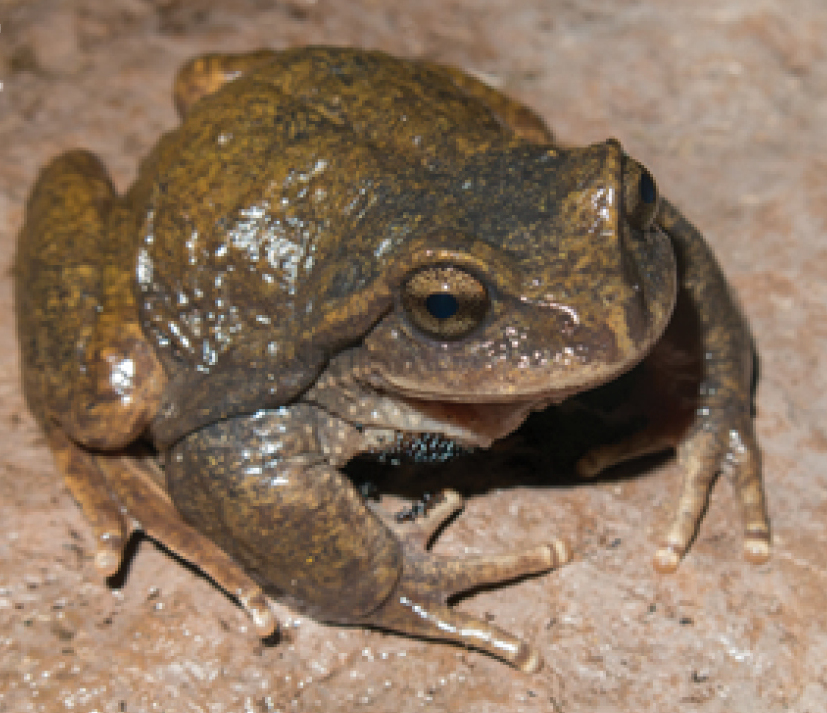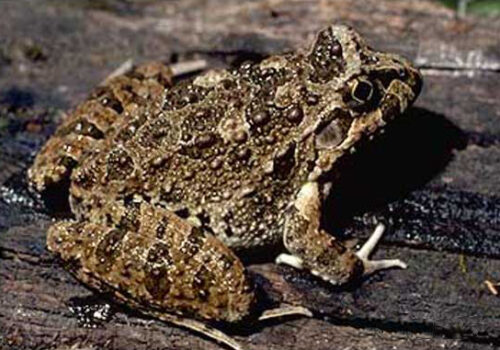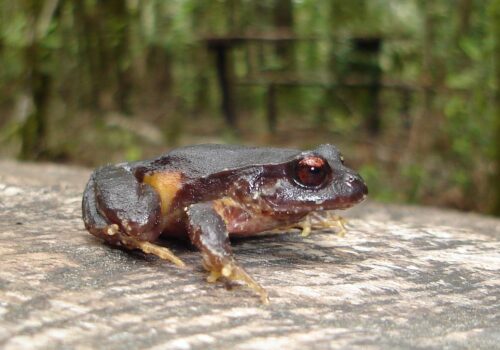- <<<a href="/?p=4831">Allophryne ruthveni</a>="/?p=4829">Allophryne resplendens</a>="/?p=4828">Allophryne relicta</a>: Chile's Fascinating and Rare Amphibian
- Taxonomy and Classification: The Family of Alsodes
- The Hidden Realm: Natural Habitat of Alsodes hugoi
- Anatomy and Physical Characteristics: Beauty in Subtlety
- Behavior and Life Cycle: Masters of Streamside Adaptation
- Ecological Connections: Alsodes hugoi’s Quiet Impact on the Ecosystem
- Facing Uncertainty: Conservation Status and Ongoing Threats
- Cultural and Scientific Importance: Why Alsodes hugoi Matters
- Ensuring Alsodes hugoi’s Future: A Call to Conservation Action
<<Allophryne ruthveni=”/?p=4829″>Allophryne resplendens=”/?p=4828″>Allophryne relicta: Chile’s Fascinating and Rare Amphibian#
In the remote, mist-covered valleys of south-central Chile, a small amphibian captivates scientists and nature enthusiasts alike. It is a creature seldom seen and scarcely known, yet abundant in mystery and ecological significance: the Alsodes hugoi, a remarkable, enigmatic frog whose existence quietly weaves into the tapestry of Chile’s unique biodiversity.
Though unassuming at first glance—small, camouflaged, and modestly colored—the Alsodes hugoi harbors secrets of evolutionary adaptation, ecological importance, and pressing conservation needs. Officially described only recently, it serves as a profound reminder of how much remains to be discovered about the natural world.
Join us as we venture into the humid forests of southern Chile to uncover the fascinating story of Alsodes hugoi—a species whose subtle beauty, intricate behaviors, and uncertain future hold lessons for us all.
Taxonomy and Classification: The Family of Alsodes#
To fully appreciate Alsodes hugoi, it helps to first understand where it fits within the intricate “family tree” of frogs. Alsodes hugoi belongs to the family Alsodidae, a small but interesting family of frogs specific to Patagonia and central Chile. Within this family, the genus Alsodes comprises around 19 recognized species adapted to various freshwater habitats, ranging from swiftly moving streams to tranquil ponds.
The species Alsodes hugoi was first described scientifically in 2001 by biologist José Núñez and colleagues. Its discovery was notable partly due to its elusive nature, calling attention to potential new species yet to be identified in Chile’s remote and understudied regions.
Close Relatives and Evolutionary Significance#
The genus Alsodes exhibits remarkable diversity, adapted to the challenges of their mountainous, often harsh habitats. Closely related species, such as Alsodes monticola and Alsodes gargola, share similar behaviors and ecological niches. Studying Alsodes hugoi not only sheds light on the unique evolutionary paths amphibians take but also helps understand the ecological resilience and vulnerabilities of closely related species across varying environmental conditions.
The Hidden Realm: Natural Habitat of Alsodes hugoi#
The Alsodes hugoi inhabits a very limited geographic range, confined largely to temperate forest streams in isolated valleys of Chile’s Araucanía Region. Here, dense rainforests of Nothofagus trees and lush undergrowth create an enchanting, sheltered environment, characterized by high humidity, cool climates, and abundant freshwater sources.
This frog species prefers pristine, clear-flowing streams nestled within the forest canopy’s protective embrace. Rocks covered in moss, decomposing logs, and the vibrant greenery adorning the riparian zones form ideal microhabitats, providing the frogs with necessary resources like food, shelter, and breeding sites. These streams, untouched by human development, harbor ample insect life—providing Alsodes hugoi with a consistent, abundant food supply.
Lurking predominantly near the water’s edge, Alsodes hugoi demonstrates a strong reliance on aquatic and semi-aquatic environments. It’s these very specialized habitat preferences that contribute to its vulnerability, as isolated forest streams face threats from human activities and climate shifts.
Anatomy and Physical Characteristics: Beauty in Subtlety#
At first glance, Alsodes hugoi might go unnoticed—a perfect testament to evolutionary adaptation. Adult frogs reach a modest length of just 30-50 millimeters, their diminutive size allowing them to easily conceal themselves among leaves, rocks, and tree roots. The muted palette of browns, olives, and subtle grayish-green shades blend seamlessly into the forest floor, providing impeccable camouflage from predators and prey alike.
Remarkable Adaptations of Alsodes hugoi#
Its skin, smooth and glistening lightly with moisture, represents a crucial adaptation, helping maintain hydration and protect the sensitive amphibian from fungi and bacteria common in damp habitats. Specialized glands scattered across their skin secrete antimicrobial peptides and mucus, vital defenses against infections—particularly essential given the global spread of amphibian pathogens like chytrid fungus.
Strong hind legs grant Alsodes hugoi remarkable agility, allowing quick escapes into nearby waters after disturbance—a behavior critical for evading birds or small mammal predators. Observational studies note the species employing stealthy inactivity during daylight hours, reserving more active behaviors for cooler, moisture-rich evenings.
Behavior and Life Cycle: Masters of Streamside Adaptation#
Alsodes hugoi exhibits notable, unique behaviors related to survival, foraging, and reproduction. Primarily nocturnal, these frogs emerge at twilight, becoming active hunters that display precise predator tactics, striking quickly at unsuspecting insect prey—particularly beetles, flies, and ants. Their diet underscores their crucial role in controlling insect populations within their ecosystem.
Breeding Behaviors and Parenting Strategies#
Breeding generally happens from late winter to early spring, aligning perfectly with seasonal rainfall that replenishes local streams and creates temporary breeding pools. Male Alsodes hugoi emit faint, distinct mating calls—a subtle, resonant melody heard near secluded, shaded watercourses. These acoustic signals—soft chirps and clicks—enchant females seeking mating partners in the dense twilight air.
Once paired, females deposit gelatinous egg masses underneath submerged rocks or vegetation, carefully protecting their developing offspring from predators and stream currents. Tadpoles of Alsodes hugoi are equally fascinating, equipped with morphological adaptations—sturdy tails, streamlined bodies—that allow them to grip submerged rocks against strong currents and enable escape from predators, thus enhancing survival.
Ecological Connections: Alsodes hugoi’s Quiet Impact on the Ecosystem#
Though small and seemingly inconspicuous, Alsodes hugoi fulfills a pivotal ecological role. As important insect predators, they help regulate insect population dynamics within their habitats, indirectly influencing plant health, nutrient recycling, and even forest health.
Simultaneously serving as prey, these frogs nourish bird species, small mammals, reptiles, and even larger amphibians. Thus, Alsodes hugoi becomes a keystone piece of a delicate ecological puzzle, reminding us of how interconnected all life forms are within nature’s intricate web.
Facing Uncertainty: Conservation Status and Ongoing Threats#
Currently classified by the International Union for Conservation of Nature (IUCN) as Near Threatened, Alsodes hugoi faces significant threats primarily tied to habitat degradation and fragmentation. Perhaps the greatest risk arises from deforestation, agricultural expansion, logging practices, urban development, and road construction—activities that drastically alter or eliminate pristine riparian ecosystems.
Climate Change and Emerging Diseases—A Looming Risk#
Climate change further compounds these existing pressures. Altered rainfall patterns, rising temperatures, and drought stressors elevate extinction risks for this delicate species dependent on specific humidity and cool streamside temperatures. Amphibian chytrid fungus (Bd), a global pathogen linked to amphibian declines, poses yet another threat, though currently, its impact on Alsodes hugoi specifically remains understudied but concerning.
Cultural and Scientific Importance: Why Alsodes hugoi Matters#
Beyond ecology, frogs like Alsodes hugoi represent important cultural and scientific significance. Indigenous groups throughout Chile recognize amphibians as symbolically significant beings, signals of ecological balance, and vital components of their spiritual and natural worlds, highlighting the profound interconnectedness to nature preserved within traditional Indigenous knowledge systems.
Scientifically, studying Alsodes hugoi provides wider insights into amphibian evolutionary biology, adaptations against fungal pathogens, ecological resilience to climate change, and conservation biology strategies essential for protecting sensitive ecosystems.
Ensuring Alsodes hugoi’s Future: A Call to Conservation Action#
The fascinating journey into the world of Alsodes hugoi underlines both the beauty and fragility of Chile’s unique amphibians. Maintaining the health and biodiversity of temperate forests and freshwater ecosystems depends critically on protecting species like Alsodes hugoi.
Individuals can support conservation efforts by advocating for sustainable forestry and conservation legislation, contributing to reputable organizations involved in habitat protection, and participating in citizen science monitoring programs.
Explore More About Related Species and Conservation Stories#
Continue your discovery by learning about other remarkable species like the Darwin’s Frog, delving into broader topics such as the importance of Rainforest Conservation in Chile, or becoming involved with grassroots efforts detailed by organizations profiled in Chilean Wildlife Conservation Initiatives.
By appreciating and taking proactive steps to support Alsodes hugoi, we help ensure its survival—and in turn, uphold the ecological integrity and captivating wonder of Chile’s highly diverse amphibian riches.











